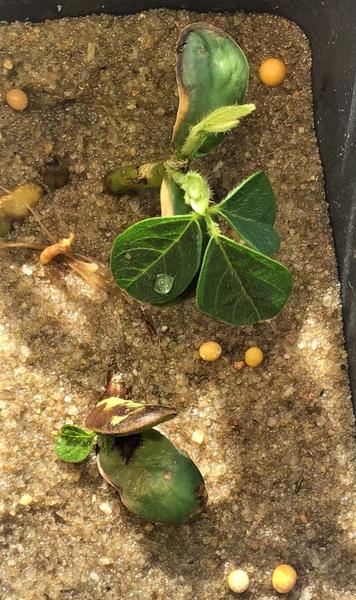Symptoms
Protoporphyrinogen oxidase (PPO)-inhibiting herbicides (herbicide group [HG] 14) inhibit the production of chlorophyll. PPO-inhibiting herbicides minimally translocation through plants, thus the injury will only occur where the spray droplets come into contact with the soybean plant. Injury incurred by PPO-inhibiting herbicides applied pre-emergence includes necrosis on the margins of cotyledons and leaves (Figure 1). Injury can occur via having treated-soil water-splashed onto the emerging plant or contact with the herbicide in the soil-water as the plant emerges. Soybeans injured by PPO-inhibiting herbicides applied pre-emergence can result in plant death if the hypocotyls are chemically-excised. Injury incurred by PPO-inhibiting herbicides applied post-emergence includes speckled-necrosis and plant stunting. The development of PPO-inhibiting herbicide injury will be rapid and injury will be greater on hot, humid days. The injury caused by PPO-inhibiting herbicides on soybeans will subside with 7 to 14 days after application. Labeled rotation restrictions should be followed to ensure that crops following soybeans are not injured by carryover of PPO-inhibiting herbicides.
Management
Labeled rotation restrictions should be followed to ensure that crops following soybeans are not injured by carryover of PPO-inhibiting herbicides. Physical drift can be avoided by spraying when .the average wind speed is less than 10 miles an hour and mid-day or –afternoon to avoid a temperature inversion
Publication date: Jan. 22, 2021
N.C. Cooperative Extension prohibits discrimination and harassment regardless of age, color, disability, family and marital status, gender identity, national origin, political beliefs, race, religion, sex (including pregnancy), sexual orientation and veteran status.
NC Cooperative Extension prohíbe la discriminación por raza, color, nacionalidad, edad, sexo (incluyendo el embarazo), discapacidad, religión, orientación sexual, identidad de género, información genética, afiliación política, y estatus de veteran.
The use of brand names in this publication does not imply endorsement by NC State University or N.C. A&T State University of the products or services named nor discrimination against similar products or services not mentioned.
Recommendations for the use of agricultural chemicals are included in this publication as a convenience to the reader. The use of brand names and any mention or listing of commercial products or services in this publication does not imply endorsement by NC State University or N.C. A&T State University nor discrimination against similar products or services not mentioned. Individuals who use agricultural chemicals are responsible for ensuring that the intended use complies with current regulations and conforms to the product label. Be sure to obtain current information about usage regulations and examine a current product label before applying any chemical. For assistance, contact your local N.C. Cooperative Extension county center.
N.C. Cooperative Extension prohibits discrimination and harassment regardless of age, color, disability, family and marital status, gender identity, national origin, political beliefs, race, religion, sex (including pregnancy), sexual orientation and veteran status.

